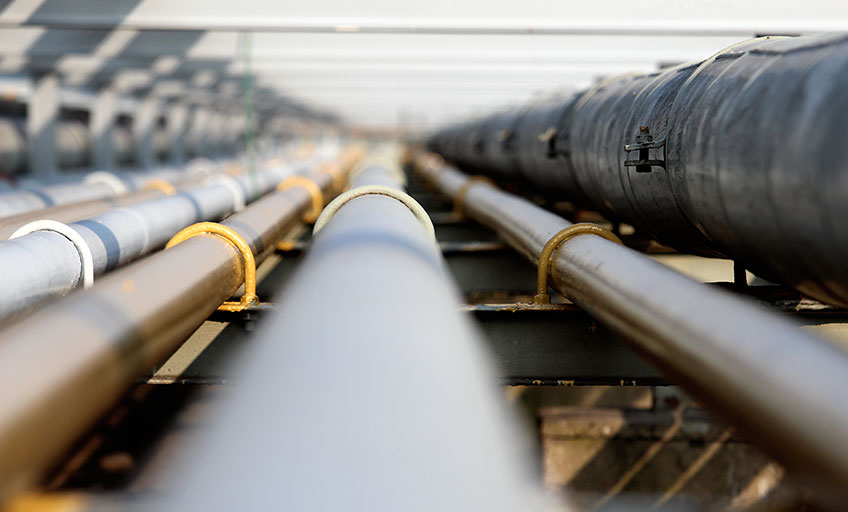HyBlend Project To Accelerate Potential for Blending Hydrogen in Natural Gas Pipelines
NREL Will Lead Multi-Lab, Multi-Industry R&D Effort To Overcome Technical Challenges

The National Renewable Energy Laboratory (NREL) will lead a new collaborative research and development (R&D) project known as HyBlendTM to address the technical barriers to blending hydrogen in natural gas pipelines.
The HyBlend team comprises six national laboratories―NREL, Sandia National Laboratories (SNL), Pacific Northwest National Laboratory (PNNL), Oak Ridge National Laboratory (ORNL), Argonne National Laboratory (ANL), and the National Energy Technology Laboratory (NETL)―and more than 20 participants from industry and academia. This two-year project was selected by the U.S. Department of Energy's Hydrogen and Fuel Cell Technologies Office (HFTO) in the Office of Energy Efficiency and Renewable Energy (EERE) through the H2@Scale 2020 CRADA Call. The team will receive more than $10 million of funding from EERE, with an additional $4 to $5 million of contributions from participants.
Blending hydrogen into the existing natural gas infrastructure has national and regional benefits for energy storage, resiliency, and emissions reductions. Hydrogen produced from renewable, nuclear, or other resources can be injected into natural gas pipelines, and the blend can then be used by conventional end users of natural gas to generate power and heat. Several projects worldwide are demonstrating blends with hydrogen concentrations as high as 20%, but the long-term impact of hydrogen on materials and equipment is not well understood, which makes it challenging for utilities and industry to plan around blending at a large scale.
"We're working with industry to answer their high-priority research questions," said Michael Peters, an engineer at NREL who is leading the HyBlend project. "First, are pipelines compatible with hydrogen? Second, what are the costs and environmental impacts? And finally, how will hydrogen blends affect appliances and other equipment in buildings?"
The HyBlend project is organized into three research tasks, each led by national laboratories with existing research and capabilities in that area:
- Hydrogen compatibility of piping and pipelines: SNL and PNNL will conduct evaluations to estimate the life of metal and polymer piping and pipeline materials (e.g., steel and polyethylene) when blends are used. This information will be incorporated into a publicly available model that can be used to estimate pipeline life given key engineering assumptions.
- Life-cycle analysis: ANL will analyze the life-cycle emissions of technologies using hydrogen and natural gas blends, as well as alternative pathways such as synthetic natural gas.
- Techno-economic analysis: NREL will quantify the costs and opportunities for hydrogen production and blending within the natural gas network, as well as alternative pathways such as synthetic natural gas.
The HyBlend effort will leverage HFTO's Hydrogen Materials Compatibility Consortium (H-Mat), led by SNL and PNNL, which is an internationally recognized framework for the study of hydrogen–materials compatibility.
"H-Mat was established by HFTO in 2018 and is already working with over 20 additional partners in industry and academia to advance materials performance," said SNL's Chris San Marchi, who will lead HyBlend research studying hydrogen compatibility with metals.
PNNL's Kevin Simmons, who will lead R&D studying hydrogen compatibility with polymers, added, "R&D led by H-Mat labs has previously enabled up to 3X improvements in the life of hydrogen storage vessels and new standards to assess the viability of polymers in hydrogen service. We look forward to using H-Mat's unique capabilities to answer critical questions regarding the feasibility of hydrogen blending."
ANL is the developer of the Greenhouse Gases, Regulated Emissions, and Energy Use in Transportation (GREET) model, a tool with more than 40,000 users worldwide, including regulatory bodies, industry, and academia. NREL leads HFTO's techno-economic analysis of H2@Scale, including both national and regional work characterizing the economic potential of hydrogen in future energy systems and the potential for hydrogen in long duration energy storage.
"Supporting the H2@Scale vision for large-scale, affordable hydrogen production, storage, distribution, and use across multiple sectors is a primary driver for the research that we're working on at NREL," said Jennifer Kurtz, director of NREL's new Energy Conversion and Storage Systems Center. "Connecting hydrogen to the natural gas infrastructure is a key piece of that, and we look forward to leading this strong team to address these important research challenges."
Learn more about NREL's hydrogen and fuel cell research.
Last Updated May 28, 2025
